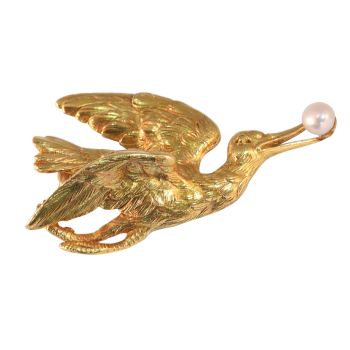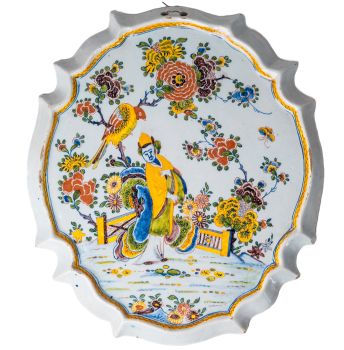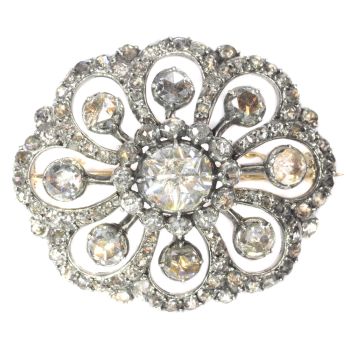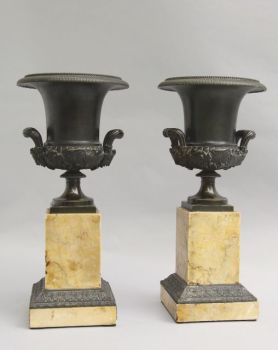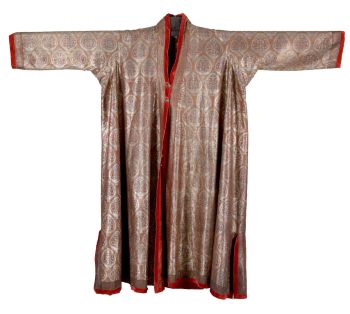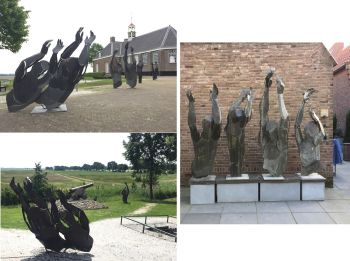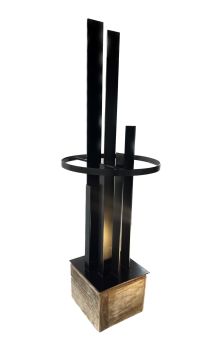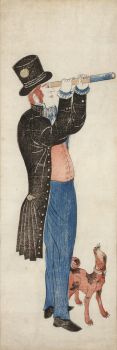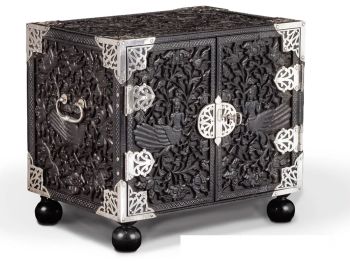A superb inlaid walrus ivory and blue glass Ottoman knife 1700
Unbekannter Künstler
KnochenGlasStahlElfenbeinMetall
Preis auf Anfrage
Zebregs & Röell - Fine Art - Antiques
- Über KunstwerkA superb inlaid walrus ivory and blue glass Ottoman knife
Ottoman Empire, Turkey, probably Constantinople (Istanbul), late 17th/early 18th-century
The hilt is formed of a faceted blue glass, while the blade of steel exhibits faux-watering and is inset with beads of coral at three equidistant slots just beneath the spine. The surface of the blade has also been etched over the greater part of its length with an inscription on one face with a part of the Nada ‘Ali quatrain and on the other with “… Muluk (?) sultan malik tahir (?)” (“… of Kings (?), Sultan Malik Tahir (?)”) among vine tendrils that exhibit remnants of the original gilding. Gilt stellar motifs also line the spine of the blade.
The scabbard is inset with a generous array of khatamkari roundels depicting celestial motifs with gems, mother-of-pearl and various metals. Of particular splendour are the ebony tesserae, which are overlaid with pointed stars in gold, some of the larger examples decorated at their centres with an inset turquoise or gold concentric circles. The craftsman has expended great efforts to ensure almost no space is left unfilled, inviting the spectator to inspect the scabbard’s surface as one might survey a busy night-sky. It is interesting to note, too, that the central roundel of the front face is decorated on a shimmering white ground in mother-of-pearl, whilst that on the reverse is black (ebony), as if the front and reverse of the scabbard signified the day and night skies respectively. The scabbard’s gilt-silver collar and chape are punched and chased to depict stylised leaves and roundels in imitation of the scabbard’s central surface, and are further inset with small turquoises as well as coloured gem stones, the chape terminating in a cross-hatched acorn finial.
L. 19.7 cm
Provenance:
With Runjeet Singh, London
This remarkable knife brilliantly exemplifies the artistry so often applied to exceptional pieces of arms and armour, its scabbard proficiently decorated throughout with roundels in a dazzling array of colours and patterns.
Remarkably, the side of the scabbard shows a zig-zag motif, to some immediately recognizable from Japanese Namban export lacquer ordered by the Portuguese. This lacquerware was not intended for the Portuguese market only and was often given as diplomatic gifts to different courts – also to the Ottoman court. The resemblance is so uncanny that it is tempting to suggest that the craftsman took inspiration from such a piece. After all, it is widely known that at the Ottoman court, too, Chinoiserie was in fashion.
A very comparable knife and scabbard can be found in the Schatzkammer of the Bavarian Palace in Munich (inv.no. 1235 or 1819/20). It probably entered the collection through the Pfälzer Wittelsbacher line, who in the 16th and 17th century were known to collect Ottoman artefacts as Turquerie, also known as Turkomania, was in vogue.
A miniature sword in the Walters Art Museum (access.no. 51.79) exhibits a similar sequence of insets along the back-edge of its blade. - Über Künstler
Es kann vorkommen, dass ein Künstler oder Hersteller unbekannt ist.
Bei einigen Werken ist nicht zu bestimmen, von wem sie hergestellt wurden, oder sie wurden von (einer Gruppe von) Handwerkern hergestellt. Beispiele sind Statuen aus der Antike, Möbel, Spiegel oder Signaturen, die nicht klar oder lesbar sind, aber auch einige Werke sind überhaupt nicht signiert.
Außerdem finden Sie folgende Beschreibung:
•"Zugeschrieben …." Ihrer Meinung nach wohl zumindest teilweise ein Werk des Künstlers
•„Atelier von ….“ oder „Werkstatt von“ Ihrer Meinung nach eine Arbeit, die im Atelier oder in der Werkstatt des Künstlers, möglicherweise unter seiner Aufsicht, ausgeführt wurde
•„Kreis von ….“ Ihrer Meinung nach ein Werk aus der Zeit des Künstlers, das seinen Einfluss zeigt, eng mit dem Künstler verbunden, aber nicht unbedingt sein Schüler
•"Art von …." oder „Anhänger von ….“ Ihrer Meinung nach eine Arbeit, die im Stil des Künstlers ausgeführt wurde, aber nicht unbedingt von einem Schüler; kann zeitgenössisch oder fast zeitgenössisch sein
•„Art von ….“ Ihrer Meinung nach ein Werk im Stil des Künstlers, aber späteren Datums
•"Nach …." Ihrer Meinung nach eine Kopie (jegliches Datums) eines Werks des Künstlers
• „Unterzeichnet …“, „Datiert …“. oder „Beschriftet“ Ihrer Meinung nach wurde das Werk vom Künstler signiert/datiert/beschriftet. Das Hinzufügen eines Fragezeichens weist auf einen Zweifel hin
• „Mit Unterschrift …“, „Mit Datum …“, „Mit Aufschrift ….“ oder „Trägt Unterschrift/Datum/Beschriftung“ ihrer Meinung nach die Unterschrift/Datum/Beschriftung von jemand anderem als dem Künstler hinzugefügt wurde
Sind Sie daran interessiert, dieses Kunstwerk zu kaufen?
Artwork details
Related artworks
Artista Desconocido
Cáliz veneciano alado1624 - 1626
Precio a consultarPeter Korf de Gidts - Antiquairs
1 - 4 / 12Artista Desconocido
EIGHT NEO-GOTHIC STAINED GLASS WINDOWS WITH SUSPENSION EYELET, 19th C, BELGIUM.1850 - 1900
Precio a consultarSpectandum Gallery
Artista Desconocido
UN NETSUKE MARINE MARFIL DE UN HOLANDÉS CON UN VENTILADOR CHINO18th century
Precio a consultarZebregs & Röell - Fine Art - Antiques
Artista Desconocido
A Japanese bronze Hu flower vase, Edo / Meiji, 19th century19th century
Precio a consultarMenken Works of Art
Artista Desconocido
UNA COLECCIÓN DE CUATRO CAJAS BÍBLICAS DE MARFIL DE SRI LANKAN18th century
Precio a consultarZebregs & Röell - Fine Art - Antiques
Artista Desconocido
UN NETSUKE DE MARFIL DE UN HOLANDÉS CON UNA COCKEREL18th century
Precio a consultarZebregs & Röell - Fine Art - Antiques
Artista Desconocido
UN RARO TELESCOPIO DE CUERO LACADO JAPONÉS GRANDE1750 - 1800
Precio a consultarZebregs & Röell - Fine Art - Antiques
Artista Desconocido
UN MODELO JAPONÉS DE UN NORIMONO, UN PALANQUÍN1650 - 1700
Precio a consultarZebregs & Röell - Fine Art - Antiques
Artista Desconocido
UN PEQUEÑO NETSUKE DE MARFIL DE UN HOLANDÉS CON UN TAMBOR1750 - 1800
Precio a consultarZebregs & Röell - Fine Art - Antiques
Artista Desconocido
The Stamford Raffles Secretaires.1800 - 1813
Precio a consultarZebregs & Röell - Fine Art - Antiques
1 - 4 / 24Artista Desconocido
A gem-set ivory sculpture of an Ottoman sultan1700 - 1750
Precio a consultarZebregs & Röell - Fine Art - Antiques
1 - 4 / 24Artista Desconocido
UN NETSUKE MARINE MARFIL DE UN HOLANDÉS CON UN VENTILADOR CHINO18th century
Precio a consultarZebregs & Röell - Fine Art - Antiques
Artista Desconocido
A Kayapo Amazon Indigenous feather headdress1950 - 1960
Precio a consultarZebregs & Röell - Fine Art - Antiques
Abraham Salm
Twenty-four chromolithographs of Java after A. Salm”1801 - 1876
Precio a consultarZebregs & Röell - Fine Art - Antiques
Artista Desconocido
A rare Japanese export lacquer medical instrument box1650 - 1700
Precio a consultarZebregs & Röell - Fine Art - Antiques
1 - 4 / 12








